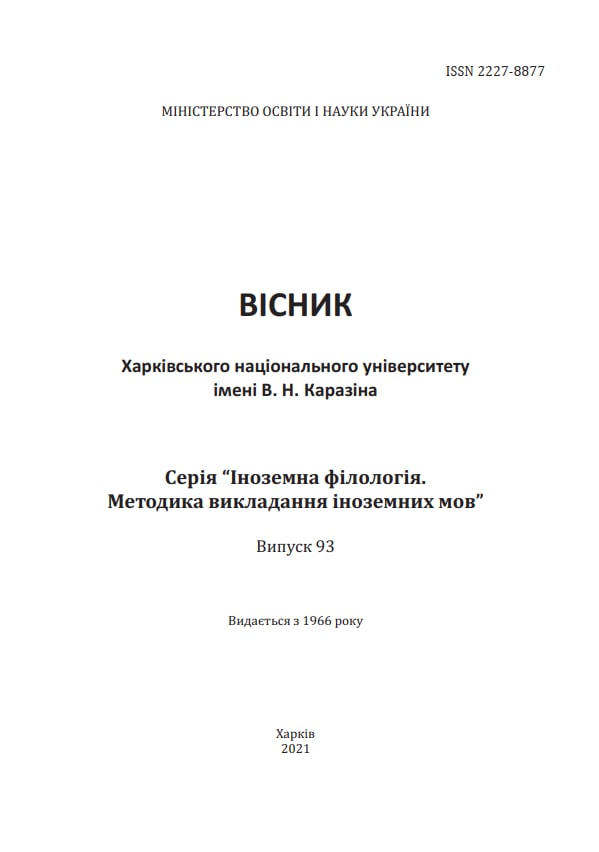Continuous Forms of the English Verb: Origin, Stages of Development
Abstract
The article deals with the study of the Old English syntactic construction «beon/wesan + Participle with the ending ‑ende» and the Middle English combination be with preposition on(a) and verbal noun in terms of their origin; the consideration of the process of formation of continuous forms in Old English, Middle English and Early New English periods on the basis of the Gospel translations: Anglo-Saxon translation 995; Wycliffe 1389; Tyndale 1526; Authorized Version of King Jacob 1611. Different views on the origin of continuous forms in English are analyzed. The process of formation of continuous forms is traced taking into account their functional load in language. The role of verbal nouns with the preposition on(a) in certain communicative situations is defined. The development of continuous forms is considered from the point of view of functionality of the existing variants, emerging as a result of the influence of linguistic and extralinguistic factors. Contacts with Celtic languages and the result of their influence on continuous forms of English verbs are studied in the periods under consideration. The conclusion is made that the Old English construction «beon/wesan + Participle with the ending ‑ende» can be considered as the prototype of modern continuous forms, but there is a possibility of its merging with the Middle English combination «be + preposition on(a) + verbal noun». Widespread in oral language, this combination only accelerated the development of continuous forms in English. Prospects for researching continuous forms of the English verb provide its further consideration from the point of view of system-functional approach that is a base of historical sociolinguistics
Downloads
References
Bosworth, J. (1888). The Gothic and Anglo-Saxon Gospels in Parallel Columns with the Versions of Wycliffe and Tyndale. London: Reeves and Turner.
Braaten, B. (1967). Notes on continuous tenses in English. Norsk Tidskrift for sprogvidenskap, 167–180.
Churjumova, A. O. (2012). Razvitie vremennyh glagol'nyh form v anglijskom jazyke (v diahronicheskom aspekte) [Development of the tense forms of the verb in English (in diachronic aspect)]. Molodoj uchenyj [Molodoj uchenyj Messenger], 7, 181–184. (in Russian)
Fisiak, J. (1996). An Early Middle English Reader. Warszawa: PWN.
Genidze, N. K. (2009). Analitizm v sinhronii i diahronii (na materiale germanskih jazykov) (Diss. kand. filol. nauk) [Analyticism in synchrony and diachrony (based on the material of the Germanic languages) (Philology PhD thesis)]. Sankt-Peterburgskij universitet jekonomiki i finansov, Sankt-Peterburg. (in Russian)
Greene, D. (1966). The Irish Language. Dublin: The Three Candles.
Gurova, Ju. I. (2013). Grammaticheskaja kategorija dlitel'nogo vremeni v drevneanglijskom jazyke [Grammatical category of continuous form in Old English]. Sovremennye problemy nauki i obrazovanija [Modern problems of science and education], 6, 51–57. (in Russian)
Gurova, Yu. I. (2018). Morfologicheskie pokazateli verbalnyih form v diahronii angliyskogo yazyika [Morphological features of verbal forms in the diachrony of the English language]. International Innovation Research, materialyi XV Mezhdunarodnoy nauchnoy konferentsii [International Innovation Research, materials of the XV International scientific conference], December. Penza: Nauka i prosveschenie, 176–180 (in Russian)
Hickey, R. (1989.). Towards a contrastive. Syntax of Irish and English. Contrastive Linguistics, 187–203.
Jespersen, O. (1954). A Modern English grammar on historical principles. London: George Allen and Unwin.
Kalenov, A. A. (2016). Izmenenie grammaticheskoy kategorii vremeni v formah glagola v sovremennom angliyskom yazyike po sravneniyu s drevneangliyskim periodom kak rezultat analiticheskogo razvitiya yazyika [Change in the grammatical category of tense in the forms of the verb in Modern English compared to the Old English period as a result of the analytical development of the language]. Molodoy uchenyiy [Young Scientist], Vol. 21, 7(111), 1159–1161. (in Russian)
Labov, U. (1975). Issledovanie jazyka v ego social'nom kontekste [The research of the language in its social context]. Novoe v lingvistike [The new in linguistics], 7, 96–182. (in Russian)
Leech, G. H. (1971). Meaning and the English verb. London: Longman Group Limited.
Liuzza, R. M. (1994). The Old English version of the Gospels. Oxford: Oxford Univ. Press.
Lockwood, W. B. (1975). Languages of the British Isles. Past and present. London: Andre Deutsch.
Logunov, T. A. (2012). K voprosu ob jevoljucii sredstv vyrazhenija budushhego (na materiale anglijskogo jazyka) [The evolution of the means of expressing the future (in the corpus of the English language)]. Vestnik Kemerovskogo gosudarstvennogo Universiteta: zhurnal teoreticheskih i prikladnyh issledovanij [Kemerovo state university bulletin: journal of theoretical and applied researches], 4(52), Vol. 4, 42–46. (in Russian)
Mosse, F. (1938). Histoire de la Forme Periphrastique "etre + participe present" en Germanique. Paris: Klincksieck.
Nehls, D. (1988). On the development of the grammatical category of verbal aspect in English. Essays on the English language and applied linguistics on the occasion of Gerhard Nickel's 60th birthday, 173–198.
Paddock, H. (1989). On explaining macrovariation in the sibilant and nasal suffixes of English. Folia Linguistica Historica. Acta Societatis Linguistical Europaeae, 9(2), 235–269.
Reshetnikova, N. D. (2014). Razvitie glagol'nyh kategorij v anglijskom jazyke [Development of verbal categories in English]. Filologija i lingvistika v sovremennom obshhestve: materialy III mezhdunar. nauch. konf., November. (pp. 92–95). Moskva: Buki-Vedi. (in Russian)
Sterling, J. (1956). The Bible. Authorized Version (1611). London: The British and Foreign Bible Society.
Tarasenko, T. V., Kuly`kova, L. A., & Ryabuxa, T. V. (2019). Osobly`vosti stanovlennya vy`dochasovy`x form perfekta v germans`ky`x movax [Features of the formation of aspect-temporal forms of perfect in Germanic languages]. Vcheni zapy`sky` Tavrijs`kogo nacional`nogo universy`tetu imeni V. I. Vernads`kogo [V. I. Vernadsky Taurida National Univ. Messenger], Vol. 30(69), № 3, Ch. 1, 172–176. (in Ukrainian)
Traugott, E. C. (1972). A History of English Syntax: A Transformational approach to the history of English sentence structure. New York et. al.: Holt, Rinehart and Winston, Inc.
Vasjukova, S. V. (2001). Tekstostruktury s dlitel'noj glagol'noj formoj v anglijskom jazyke (Diss. kand. filol. nauk) [Text structures with continuous form of the verb in English (Philology PhD thesis)]. Tulskiy gosudarstvennyiy universitet, Tula. (in Russian)
Wyatt A. J. (2019). An Anglo-Saxon Reader (I. The Chronicle. II. Alfred's Orosius. III. Cura Pastoralis). Cambridge: Cambridge Univ. Press.




